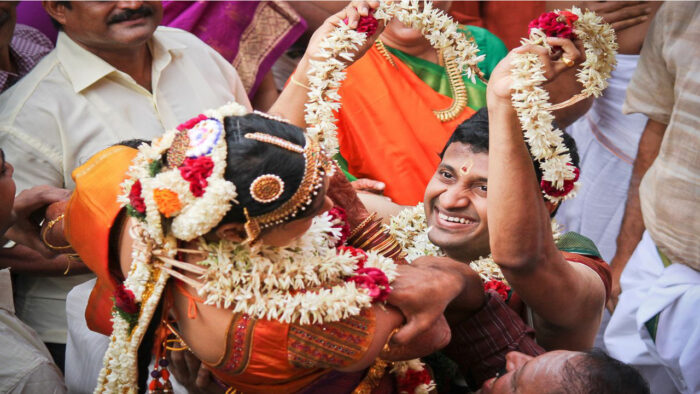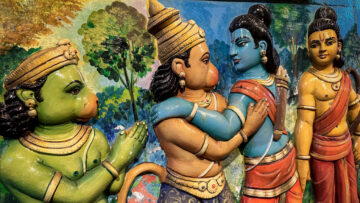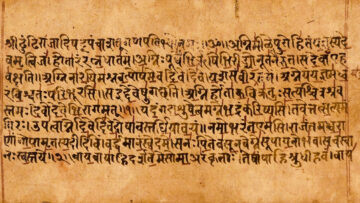A Tamil wedding that I attended recently felt like a family reunion that fulfilled the promise of the engagement I wrote about early this year, where two families first came together with a shared commitment. While the engagement was a delightful vow to join lives, the wedding bound a couple and their families in a lifelong bond, carrying traditions forward through generations. It was a profound spiritual, cultural, and social event, often referred to as Vivaham, signifying not just the union of two individuals, but the coming together of their lineages.
To understand Vivaham, one needs to understand Dharma.
Dharma
In Hindu thought, Dharma sustains the natural order of life, guiding individuals and society towards harmony and purpose1.
This natural order applies to the universe as it does to individuals.
This natural order is seen in the universe’s ungoverned patterns – sun rises and sets, day and night repeat, stars form and fade, planets revolve, seasons repeat – and in human life’s journey of birth, marriage, aging and death repeating across generations2.
This natural order works in cycles, more specifically eternal cycles, known as rta.
Sanatana Dharma directs human actions to align with this natural order, or the eternal cycle.
Vivaham embodies this at different levels:
- At a Personal level, it fosters love, trust, and mutual support, rooting the couple’s life in togetherness.
- For Society, it strengthens family bonds and community ties through rituals like honoring ancestors, uniting people in shared values.
- At the State level, it promotes social harmony by building stable families as the foundation of a just society.
- At the Universal level, it ties the couple’s union to the cosmic balance of creation and renewal.
Thus, Vivaham balances personal joy with collective duty that sustains the natural order at different levels.
Vivaham
The Vivaham was a three day event full of rituals giving life’s big moment a sense of purpose rooted in Hindu philosophical institutions. Its role in building family as a dharmic institution shines through various rituals.
What do I mean by that?
In Hindu philosophy, institutions like Purusharthas, Varna-jati, and Ashramas sustain the social order by balancing rights and duties at personal and societal levels.
- Purusharthas (Dharma, Artha, Kama, and Moksha) guide life’s purpose, with Vivaham fulfilling Dharma and Kama through family responsibilities and love.
- Varna-Jati organizes social roles, and marriage strengthens community ties by uniting families within these structures.
- Ashramas (Brahmacharya, Grihastha, Vanaprastha, Sannyasa) mark life stages, with Vivaham initiating the Grihastha phase, where family life upholds societal duties.
Watching the families prepare for the start of Day 1 rituals in the lively hall, I felt the deeper meaning of a tradition that binds us to each other and our heritage in a way I’ll never forget.
- Spiritually, it signifies a divine partnership, as Vedic teachings guide them towards a shared life of duty and purpose.
- Culturally, it is a celebration of heritage, with many rituals passing down values that tie us to our roots.
- Socially, it’s a joyful gathering that brings relatives and friends together, creating memories for future generations.
The ambience was elevated by the soulful melodies of the Nadaswaram and the rhythmic beats of the Thavil. Both the instruments, known as the Mangala Vadyam have always been integral to the wedding ceremony.
This wedding held special meaning for me: the bride’s father, a first cousin, was our family’s first engineer and a role model who inspired many in our family to pursue engineering careers. I saw his daughter’s wedding as a celebration of our journey in this regard.
For months leading up to this momentous occasion, the bride’s family poured their hearts into every detail of the planning, from the elaborate décor to the intricate rituals, in consultation with the groom and family as required. Their joint efforts brought back the sense of togetherness experienced during the engagement, but on a grander scale.
The wedding unfolded over three days with rituals and celebration to align with rta.
- Day 1 kicked off with preparatory rituals where families came together to pray and set the stage for life’s journey ahead.
- Day 2 brought the heart of the wedding, uniting the couple in front of loved ones.
- Day 3 wrapped up with blessings and wishes, sending the couple into their new life with love and support.
Understanding Vivaham’s Rituals
To fully grasp the significance of Vivaham’s rituals, one must understand the concept of Rna alongside Rta.
In Hindu tradition, Rna refers to the spiritual and moral debts humans owe to deities, ancestors, sages, fellow human beings, and nature. These debts arise because life and sustenance are gifts from deities, ancestors provide lineage, sages share Vedic wisdom, fellow human beings offer societal support, and nature ensures environmental balance2.
There are five types of Rna – Deva Rna, Pitr Rna, Rishi Rna, Nru Rna, and Bhuta Rna. They are all lifelong obligations.
Vivaham’s rituals contribute to clearing a portion of these debts, marking a significant step in fulfilling one’s responsibilities to uphold Dharma and earn good karma, as part of a lifelong commitment.
- Through rituals, families honor deities, addressing Deva Rna by seeking blessings that sustain cosmic balance.
- They pay respect to ancestors, addressing Pitr Rna by acknowledging lineage and securing blessings for future generations.
- The use of Vedic chants and teachings addresses Rishi Rna by preserving sages’ wisdom, guiding the couple toward righteous living.
- Community gatherings and shared celebrations address Nru Rna by strengthening bonds with fellow human beings.
- Rituals like sowing seeds and using natural elements honor nature, addressing Bhuta Rna for environmental harmony.
Thus, Vivaham’s rituals reflect the guiding principles of Hindu metaphysics.
I explain each day’s rituals in the sections that follow, accompanied by a summary of how they align with Rta and Rna.
Day 1: Key Rituals and Significance
Day 1 set the foundation for the wedding
The groom and his family were given a traditional welcome by the bride’s family with Arthi, the auspiciousness of the occasion elevated by Mangala Vadyam.
As is the norm, the day started with Pillaiyar poojai, a prayer to Ganesha to seek his blessings for a smooth wedding and clear the way for an auspicious start.
This was followed by Punyahavachanam that sanctifies the stage, people and other paraphernalia by sprinkling holy water and chanting mantras.
Pandal Kaal Muhurtham was performed to offer prayers to a deity in the form of a bamboo pole on the stage for a successful wedding ceremony.
Viratham was kicked off thereafter, with both the bride’s and groom’s families performing separately, but concurrently. This involves redoing some of the rituals from childhood such as jatha karma, naama karma, and some more, as appropriate, for the bride and the groom.
In a special ritual called Naandhi, brahmins representing ancestors of the groom and the bride were invited and honored with gifts. This act of ancestor worship is a bridge to our past, honoring the lineage that shaped our family and seeking guidance for the couple’s future.
A fertility ritual called Paaligai seed sowing was performed by planting nava daanyams, in a symbolic act to seek the blessings of nine devatas for fertility, the couple’s health and well-being, concluding on Day 3.
Viratham also marks the transition from Brahmacharya (student phase) to Grihastha (householder phase) stage of life.
Nishchayathartham formalized the families’ commitment to the marriage, beginning with Pillaiyar Poojai. The parents gathered to affirm the union, with the priest reading the wedding invitation (Lagna Pathrikai) and announcing lineage details for three generations, the wedding location, and the muhurtham timings for the following day.
Mangala Vadyam elevated the moment.
Namasankeerthanam, honoring my cousin’s late father’s Radha Kalyanam tradition started in 1976 in Kumbakonam, celebrated the divine union of Radha and Krishna, uniting families in devotion and nostalgia.
The day concluded with the Reception, a joyful gathering where friends and family shared blessings, gifts and wishes for the couple’s future.
The rituals of Day 1 addressed the five Rna debts to align the couple’s union with Rta. Pillaiyar Poojai and Pandal Kaal Muhurtham sought blessings from deities, honoring Deva Rna to sustain cosmic balance. Naandhi paid respect to ancestors, addressing Pitr Rna by acknowledging lineage and securing blessings for future generations. Vedic chants in Punyahavachanam and Namasankeerthanam preserved the wisdom of sages, fulfilling Rishi Rna to guide the couple’s path. The Nishchayathartham and Reception united loved ones, addressing Nru Rna through shared bonds. Paaligai’s sowing of seeds, mirroring Rta’s cycle of growth, honored nature, addressing Bhuta Rna for environmental harmony.
Day 2: Key Rituals and Significance
Day 2 was the heart of the Vivaham.
The day began with Kasi Yathirai, a playful yet meaningful moment during the wedding. The groom, dressed in traditional attire, pretended to leave for Kashi, carrying an umbrella and a book to signal a solitary Brahmacharya life of learning. The bride’s father stepped in, affectionately persuading him to return back for the bride’s sake, and to choose love and family duty over solitude, thus transitioning to the Grihastha stage. His gentle words carried the weight of Dharma, celebrating the value of partnership in married life. This was a pivotal moment in the wedding. This lighthearted exchange blended humor with the cultural significance of choosing togetherness.
The next ritual was the Maalai Matrudhal. This is also a fun ceremony in which the bride and the groom were lifted by their respective families and made to exchange garland thrice. The effort was made a bit difficult for the other by moving backward or by lifting higher.
What followed was Oonjal. In this ritual, the couple sat together on a decorated swing, symbolizing harmony and a sweet life ahead. The swinging motion represented the ups and downs in life. Married women from both families sang traditional songs and fed them milk and bananas, indicating stability and sweetness in life. This deeply symbolic act signified purity, abundance and fertility.
Pachai Podi, a ritual involving the application of green powder and turmeric paste, followed, purifying the couple and preparing them for life ahead. Rice cakes were thrown in all directions to ward off evil eyes and to ensure the couple’s well-being.
As the Muhurtham time was approaching, the next ritual, called Kanya Dhaanam, kicked off. Family from both sides assembled on the stage, some of us comfortably sat down. In this ritual, the bride sat on her father’s lap holding betel leaves and banana, with the bride’s mother pouring water on it, the gesture symbolizing the giving away of their daughter to the groom.
The significance of Kanya Dhaanam must be underscored here.
The active participation of married women in spiritual and familial duties is essential in hindu tradition, as many rituals cannot be performed without their presence. This vital role challenges common misconceptions about the diminishing status of women in Hindu society, showcasing their importance in upholding Dharma. The Kanya Dhaanam ceremony beautifully exemplified this tradition; it involved the bride’s father lovingly presenting his daughter to the groom. This act facilitated a divine union crucial for sustaining the institution of marriage. It is for this reason that Kanya Dhaanam is considered to be the highest form of Dhaanam in Hindu culture. This moment, set to the Mangala Vadyam’s, filled the hall with emotion as the bride’s family entrusted her to a shared life of duty and love.
Maangalya Dharanam followed. This is the crux of the ceremony. Tears of joy rolled down the bride’s face, amidst the chanting of vedic hymns by priests. The groom prepared for the big moment. Surrounded by close family from both sides, the groom tied the Thali or Mangala Sutra around the bride’s neck, formalizing the partnership. They became a married couple at this juncture.
Pani Grahanam followed, in which the groom accepted the bride’s hand in the marriage.
Kanya Dhaanam, observed from the bride’s viewpoint, and Pani Grahanam, from the groom’s, represent two facets of the same tradition.
Marrying off a daughter is considered a big responsibility in Hindu culture. When the bride’s parents entrusted her to the groom, tears of joy flowed in the faces of the bride, her parents and brother, reflecting an emotional fulfilment of seeing her begin a new life.
The tears reflected the psychological gain for the bride’s family.
This was followed by greetings by the near and the dear wishing them abundance in the life ahead.
Sammandhi Mariyadhai happened during this time, where the parents of the bride and the groom exchanged gifts to celebrate the occasion.
Additional rituals followed, involving the bride and the groom that sanctified the union.
This was followed by Saptha Padi. The newlyweds took seven steps representing companionship for life.
The bride then stepped on to a grindstone with the help of the groom to symbolically affirm the bride’s strength and stability in married life. The groom placed metti (toe rings) on her toes. This is called Ammi Midthithal. This signifies the groom’s respect and humility towards the bride.
This was followed by Grihapravesam, a ritual in which the bride was welcomed into the groom’s home for the first time. Since the wedding took place in a wedding hall, it happened in the groom’s room symbolically. Several family elders from the bride’s side participated in this ritual.
Nilangu started at 5:30 pm which brought a burst of playful competition to the wedding hall. The bride and the groom engaged in fun games like rolling a coconut or applying sandalwood paste, each trying to outdo the other with laughter and cheers filling the air. It is said that this tradition was carried on from ancient times when the bride and the groom were much younger, often strangers, who needed to feel at ease and become familiar with each other.
What came next was Sesha Homam, to mark the completion of all wedding rituals. An integral component of this was the sighting of the Arundhati star by the newly wed couple. In Hindu weddings, the Arundhati star sighting held deep meaning as the newlyweds looked at the star, symbolizing marital fidelity and devotion. This has profound significance since Rig Vedic times. Named after Arundhati, the devoted wife of Sage Vashishta (one of the rishis in Rig Veda), this ritual blessed the couple with a lifelong loyalty and love.
Day 2’s rituals addressed the four Rna debts to harmonize the couple’s union with Rta. Kasi Yathirai and Maangalya Dharanam sought blessings from deities, honoring Deva Rna to maintain cosmic balance. Kanya Dhaanam and Pani Grahanam acknowledged ancestors through family participation, addressing Pitr Rna for lineage continuity. Vedic hymns in Maangalya Dharanam, formalizing the union under Rta’s order of creation, and Sesha Homan fulfilled Rishi Rna to guide righteous living. Oonjal, Sammandhi Mariyadhai, and Nilangu fostered bonds with loved ones, addressing Nru Rna through community celebration.
Day 3: Key Rituals and Significance
Day 3 marked the completion of the wedding ceremony.
On this day, Paaligai concluded with the sprouted nava daanyams from Day 1 being immersed in water, a symbolic act seeking blessings from nine devatas for the couple’s fertility and prosperous future.
There was Paladhaanam, a ritual where newly married couples sought blessings from elders by touching their feet and offering a token amount of money. This signified the importance of respecting and seeking blessings from family elders in the tradition.
Following this, the bride’s father, the bride herself, and a few others gave sincere speeches, thanking everyone who attended and helped make the wedding unforgettable, their words filled with gratitude.
Then Kattu Sadham, meaning packed rice, was distributed to everybody. This is a standard menu in Tamil brahmin weddings – podi idli, puliyodhare, the quintessential thayir sadham, vadam and moru milagai. The bride’s family gave the groom’s family, and everyone else parting gifts of food for their journey towards their home and to give a respite from cooking upon reaching the destination.
As the wedding ended, relatives exchanged emotional goodbyes, heading to their respective destinations carrying the joy of rekindled family bonds and cherished memories.
Day 3’s rituals concluded the Vivaham by addressing the five Rna debts, aligning the couple’s union with Rta. Paaligai’s immersion of sprouted grains, reflecting Rta’s cycle of renewal, invoked blessings from deities, honoring Deva Rna for prosperity and renewal. Paladhaanam respected ancestors through elder blessings, addressing Pitr Rna for lineage wisdom. Vedic traditions in these rites fulfilled Rishi Rna, guiding the couple with sacred knowledge. Kattu Sadham and expressions of gratitude united loved ones, addressing Nru Rna through shared celebrations. Paaligai’s respect for nature’s cycles honored Bhuta Rna for environmental balance.
Conclusion
Vivaham is a sacred ceremony that binds families through Dharma.
Rooted in Hindu metaphysics the three days of rituals reflect Sanatana Dharma’s guidance for a life aligned with the natural order.
Contrary to negative perceptions that often cast women as secondary in Hindu culture, rituals such as Kanya Dhaanam and Oonjal highlight the essential presence and crucial roles of married women demonstrating their vital status in Hindu thought and their importance in upholding Dharma.
Unlike western notions that prioritize individual rights, Hindu thought emphasizes a balance of rights and duties, a principle clearly evident in the wedding rituals.
It must be reiterated here that the groom’s family, with their gracious approach, mirrored the spirit of unity I wrote about in the engagement.
Having lived abroad for over three decades and attended only a few family weddings, this reunion felt like a true homecoming. It rekindled bonds with cousins, uncles, and aunts not seen in years, their laughter and banter creating cherished memories that highlight the enduring nature of family ties.
The warmth of this ceremony will linger in my heart for years to come.
References
- Mahabarata Unveiled by Ami Ganatra, Bloomsbury, 2021.
- Svayambodha and Shatrubodha by Pankaj Saxena, BlueOne Ink, 2025.
Feature Image credit: in.pinterest.com
Disclaimer: The opinions expressed in this article belong to the author. Indic Today is neither responsible nor liable for the accuracy, completeness, suitability, or validity of any information in the article.










